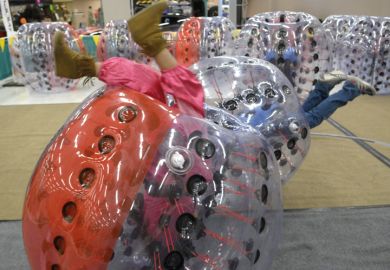The concept of the flipped classroom has been gaining traction as a pedagogical approach for three decades, with its adoption rapidly increasing in recent years: more than half of US universities now employ the model.
However, academics remain at odds over whether the technique – in which students digest new educational content outside the classroom and then use contact time to discuss, apply and deepen their knowledge – is an improvement on the “out-of-date” traditional lecture, or whether the reason the lecture format has stuck around so long is because it is effective.
As the popularity of the flipped classroom has grown, the critics of the lecture have grown more vocal. Carl Wieman, a Nobel prizewinning physicist at Stanford University, has described the chalk-and-talk approach as being akin to “bloodletting in the era of evidence-based medicine”. According to Professor Wieman, the evidence is clear that “active learning instruction consistently achieves better student outcomes than lectures” across a wide range of disciplines.
Nevertheless, the lecture remains difficult to dislodge as academics’ instructional method of choice, and doubts remain about the effectiveness of the flipped classroom: a survey of 290 European universities last year found that it was the least popular of five teaching innovations considered. Only 15 per cent considered the model to be “fully useful”, while 39 per cent said that it was useful to some extent.
Defenders of the lecture, such as James Conroy, the University of Glasgow’s vice-principal for internationalisation, highlight that the “much maligned” lecture actually “requires concentration, analysis and judgement”, which are important skills for students to learn.
A scholarly grenade was tossed into the debate this summer with the publication of a paper that found that switching to the flipped classroom failed to improve student performance. Researchers analysed results of 1,328 students at the United States Military Academy using data from in-class quizzes and end-of-year exams and found that the group taught via the flipped classroom method did no better than those who had lectures. The study also showed that the model might exacerbate achievement gaps between different groups of learners.
The paper, published by the Massachusetts Institute of Technology, has been criticised on several grounds: for example, the profile of students and the academic regime in a military academy is significantly different from those of a typical university, and the study focused on students from a narrow range of disciplines, specifically economics and mathematics. Furthermore, all the lecturers taking part in the study were new to the flipped classroom method, and the comparatively simplistic preparatory material – video recordings of lectures, as opposed to, for example, independent research – may have been a factor in students’ results.
So where does the scholarly consensus now lie on the value of the flipped classroom approach? And, if it is to be implemented, how can it be done most effectively? The MIT paper is by no means the only research project to have shed light on the strengths and drawbacks of the approach. Some studies have come to similar conclusions: a 2013 study at Brigham Young University found “no significant difference” between the achievement and perceived learning gain of students taught by flipped or traditional teaching methods. A 2012 study of students at Middle Tennessee State University found that those in a flipped classroom “were less satisfied with how the classroom structure oriented them to the learning tasks in the course”.
In contrast, a 2019 literature review, conducted by academics at Utrecht University, studied 114 papers and found that the flipped classroom had “a small positive effect on learning outcomes” overall. A 2018 review of 28 papers published in BMC Medical Education that focused on the experience of students in health professions concluded that there was an overall “significant effect” in favour of flipped classrooms. In addition, the paper found that the majority of respondents said they preferred flipped to traditional classrooms.
Other studies have drawn out nuance in the debate. A 2018 literature review by academics at the University of Florida analysed 55 studies and found a “statistically significant effect” in favour of the flipped classroom, but concluded that disciplinary differences were important to take into consideration – engineering was particularly well suited to flipping, they said. The authors added that “other forms of blended learning appear to have a stronger effect on student learning outcomes”.
A broader problem is that many of the studies focusing on the flipped classroom have been observational, as opposed to experimental, and have often involved relatively small sample sizes.
Paul Wyatt, a professorial teaching fellow in the University of Bristol’s School of Chemistry, said that it “can be tricky” to place a numerical value on the effect of the flipped classroom. However, he has implemented a model for his undergraduate courses in which half the lectures are flipped and half are not, and he reports that students were “very engaged” with the format and that the majority of the feedback had been positive. Many students said it helped them to truly learn the material rather than just passively take in information, he said.
Professor Wyatt said he enjoyed teaching in this way. “I’m interacting with [students] when I teach them; it’s much more fun. It is difficult for students to enjoy themselves when you are not enjoying it. It is a virtuous circle,” he said.
Simone Buitendijk, vice-provost for education at Imperial College London, agreed that this was an overlooked but important element in the debate. “It’s OK to make teaching fun,” she said.
Professor Buitendijk said that although she did not believe that the lecture should be consigned to history, the flipped classroom was a useful tool to make learning more interactive. “At Imperial, we are still part of a relatively small group of pioneers, but I’m convinced it will spread. We won’t do lecturing as our prime way to teach, but it’s a work in a progress.”
She added that it would require a change in the wider ecosystem to accelerate the uptake of the flipped classroom because assessment would need to evolve to reflect the more interactive nature of learning. Most research-intensive universities still have not put enough time, effort or money into overhauling their teaching, she argued, and “if you are a really busy person, you will teach the way you’ve always done it. So it needs to be a strategic effort.”
Effort is a key issue, because academics agree that adopting flipped learning is a fairly significant undertaking that must be underpinned by strong pedagogy.
“If you simply videotape a boring lecture, that’s not going to work; that’s worse than the boring lecture in person,” Professor Buitendijk said. “You really need to think about what you put online, [and] how students relate with the video material.”
Professor Wieman strongly agreed. He told Times Higher Education that the flipped classroom was a format that made it easier to embark on active learning, but there was “nothing in the definition of a flipped classroom that says [teachers] are putting in the right kinds of activity”.
“Sitting there watching a lecture on a monitor is no more effective than [watching a lecture] in person. What really matters is what happens in the classroom,” Professor Wieman said. If the teacher designs their flipped classroom teaching with evidence-based active learning techniques, it will work; if not, it won’t, he said. Approaches that are advocated by researchers include problem-solving, experiential learning and peer assessment – not just group discussions.
The 2018 Florida literature review backed this up: the variation in the results of different research papers on flipped learning was likely attributable to the “considerable variability in the design and implementation of flipped classrooms”, it said.
Professor Wyatt said he believed that the positive feedback that his flipped teaching received had a lot to do with the fact that he made lecture recordings specifically for the lessons, rather than using recordings of old lectures, which he found were not liked by students. He also emphasised the importance of using technology effectively – in his case, polling software.
“I deliberately only flip half the course to anchor it in something familiar,” Professor Wyatt added. The flipped lessons should not make extra work for the students – they are supposed to have personal study time, and it’s just flipping that, he explained. However, students who have succeeded throughout their education by cramming might feel that they have to make a lot more effort, and they will need convincing, Professor Wyatt said.
He also cautioned against a top-down approach to implementing the flipped classroom across a university. “The thing with all innovative teaching is that it doesn’t work if teachers are told, ‘You have to do this,’” Professor Wyatt said. “It has to come from the lecturer thinking, ‘This might work for me, and I’d like to try that.’”
POSTSCRIPT:
Print headline: Does turning learning on its head deliver?
Register to continue
Why register?
- Registration is free and only takes a moment
- Once registered, you can read 3 articles a month
- Sign up for our newsletter
Subscribe
Or subscribe for unlimited access to:
- Unlimited access to news, views, insights & reviews
- Digital editions
- Digital access to THE’s university and college rankings analysis
Already registered or a current subscriber? Login








